A family of swans on Lake Ohrid - little swan knowledge
- Written by Portal Editor
You can almost set your clock by it, because every day a family of swans appears promptly in the morning and again in the late afternoon. She is on the shore of Lake Ohrid directly in front of the Rino campsite on the way to and from her various fishing spots.
Swans feed primarily on aquatic plants collected from the bottom of the lake, a relatively easy task in the truly clean and clear waters of Lake Ohrid. However, for some camping guests it was always a special pleasure to provide the young swans with additional food in the form of leftover bread.
It is therefore extremely rare for couples to separate.
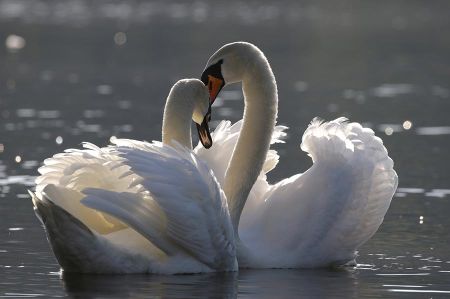 Swan couples commit to each other for life, unlike many people, where they actually promise each other lifelong loyalty and then don't keep it. During a study of a group of mute swans, it was even found that 97% of the successfully breeding animals bred again with the same partner the following year.
Swan couples commit to each other for life, unlike many people, where they actually promise each other lifelong loyalty and then don't keep it. During a study of a group of mute swans, it was even found that 97% of the successfully breeding animals bred again with the same partner the following year.
It is therefore extremely rare for couples to separate. For example, the Bewick's swan, which has a lifespan of up to 27 years, was found to have a pair bond of at least 19 years. Accordingly, it is difficult for older swans that have lost their partner to find a new partner.
Four to six eggs are laid, which are incubated for around 40 days
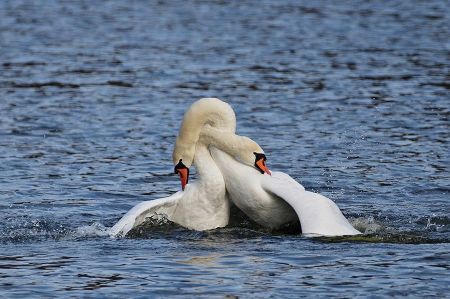 The swans' nest is built from aquatic plants, grasses and twigs and is often of considerable size. Because a pair uses the same nest over and over again, it can expand from year to year. The male swan swims or stands with his back to the nest on which the female is sitting and hands her the nesting material with a backward movement of his head and neck. Later, the nest is thinly padded with down by the female. Breeding is then carried out solely by the female, although in the case of the black swan the male also takes part in this. Four to six (rarely one to eleven) eggs are laid, which are incubated for around 40 days. The boys are accompanied by both partners. Occasionally they are transported on their backs. Swans that have fledged usually remain in an association with their parent birds until the next reproductive period.
The swans' nest is built from aquatic plants, grasses and twigs and is often of considerable size. Because a pair uses the same nest over and over again, it can expand from year to year. The male swan swims or stands with his back to the nest on which the female is sitting and hands her the nesting material with a backward movement of his head and neck. Later, the nest is thinly padded with down by the female. Breeding is then carried out solely by the female, although in the case of the black swan the male also takes part in this. Four to six (rarely one to eleven) eggs are laid, which are incubated for around 40 days. The boys are accompanied by both partners. Occasionally they are transported on their backs. Swans that have fledged usually remain in an association with their parent birds until the next reproductive period.
Irish mythology uses swans very frequently in its symbolism
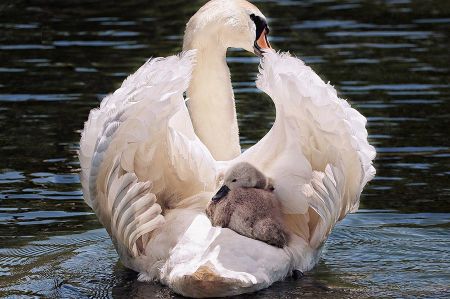 When they come ashore, swans also eat plants growing on the shore. In addition, a much smaller proportion of aquatic insects, molluscs, small fish and amphibians are eaten. Because of the pure white plumage of the European species and their impressive size, swans have become part of numerous myths and fairy tales, and images can also be found in many floor mosaics from Roman times. Swans have often inspired the human imagination: not only the myth of Leda or the Swan Song bears witness to this, but also fairy tales such as The Ugly Duckling bear witness to this. In this fairy tale, the swan symbolizes, among other things: Maturation and perfection, it is used in art and literature but also as an allegory for purity. In this context, one should mention Richard Wagner's swan knight Lohengrin, whose boat is pulled by a swan. Irish mythology uses swans very frequently in its symbolism.
When they come ashore, swans also eat plants growing on the shore. In addition, a much smaller proportion of aquatic insects, molluscs, small fish and amphibians are eaten. Because of the pure white plumage of the European species and their impressive size, swans have become part of numerous myths and fairy tales, and images can also be found in many floor mosaics from Roman times. Swans have often inspired the human imagination: not only the myth of Leda or the Swan Song bears witness to this, but also fairy tales such as The Ugly Duckling bear witness to this. In this fairy tale, the swan symbolizes, among other things: Maturation and perfection, it is used in art and literature but also as an allegory for purity. In this context, one should mention Richard Wagner's swan knight Lohengrin, whose boat is pulled by a swan. Irish mythology uses swans very frequently in its symbolism.
Harassment of the Alster swans (mute swans on the Alster) is punishable
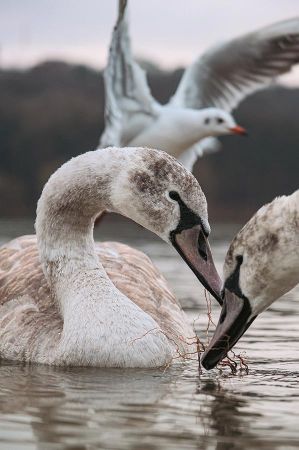 In Middle Ages Europe, keeping swans on open water was considered a sovereign right. As a political symbol of imperial immediacy, for example In 1664, for example, the Hamburg City Council made harassment of the Alster swans (mute swans on the Alster) a punishable offense. There is evidence of food payments from the city to the animals from 1591 onwards. Today the animals are still looked after by a swan keeper.
In Middle Ages Europe, keeping swans on open water was considered a sovereign right. As a political symbol of imperial immediacy, for example In 1664, for example, the Hamburg City Council made harassment of the Alster swans (mute swans on the Alster) a punishable offense. There is evidence of food payments from the city to the animals from 1591 onwards. Today the animals are still looked after by a swan keeper.
Because swan protection has existed for centuries in many countries, there is little current experience and research with their consumption as human food. From the Carmina Burana of the 11th to 13th centuries, a song about a swan roasted on a spit is known, not least because of the setting of the same name by Carl Orff (Cignus ustus cantat: “Olim lacus colueram”). In England, swans were on royal menus alongside peacocks and herons. It is reported that the English King Henry III. In 1251 he needed 125 swans for his Christmas banquet. Recipes for “baked swan”, for example, have been handed down from centuries past. The increasing disappearance of swans from farm menus coincided with the appearance of the turkey in Europe after the discovery of America.
Sir Peter Maxwell Davies, Royal Master of Music since 2004
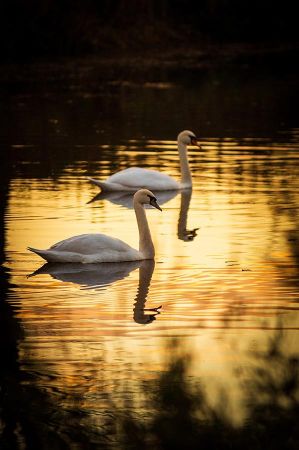 These days it is often reported that swan meat is tough, tastes muddy and fishy. On the other hand, Sir Peter Maxwell Davies, Royal Master of Music since 2004, considers swan terrine prepared with leg and breast meat from aged animals to be “delicate”. He said the meat was dark with a strong flavour reminiscent of pheasant and also a bit of venison. In connection with the consumption of swan meat, it is recommended to hang the meat for four days, as bacteria during this time make the meat more tender and improve the taste.
These days it is often reported that swan meat is tough, tastes muddy and fishy. On the other hand, Sir Peter Maxwell Davies, Royal Master of Music since 2004, considers swan terrine prepared with leg and breast meat from aged animals to be “delicate”. He said the meat was dark with a strong flavour reminiscent of pheasant and also a bit of venison. In connection with the consumption of swan meat, it is recommended to hang the meat for four days, as bacteria during this time make the meat more tender and improve the taste.
However, many people may see it, we always prefer swans and their offspring in living form. They glide through the water almost majestically and become almost aggressive if you get too close to them. Always they are beautiful to look at, especially alive.
Please read as well:
The famous Matka - Canyon, Dam and Gorge near Skopje
Heracleia Lyncestis - a day trip to Bitola
https://www.alaturka.info/en/life/fauna/6389-a-family-of-swans-on-lake-ohrid-little-swan-knowledge?layout=default#sigProId3399edcf0f
